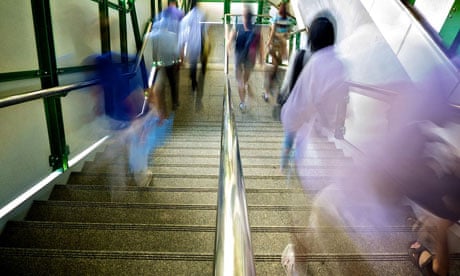We don't need a survey to prove that stress levels for academics are higher than those in the general population, but we have one anyway.
Long hours, heavy teaching and admin loads, along with expectations of research activity all have telling effects. While much could be done in the university workplace to foster better working environments, we're also doing ourselves and our career an unintended disservice when we prioritise work ahead of wellbeing.
This dedication to the task is often a false economy. If we just did the counterintuitive – took a break, talked to colleagues, walked up and down some stairs, went to bed sooner, took the time to make a decent lunch and ate that lunch with other people rather than at our desks – our performance would go up, our time on task would go down and our quality of life would improve.
Through ongoing research at Southampton's human performance design lab in electronics and computer science, we have defined a model to understand wellbeing in the body. We call this map the inbodied5, or five core processes that interact with each other: movement, eating, social engagement, cognitive engagement, and sleep.
Eating and sleeping: While it may seem obvious that eating is a requirement for life (don't eat – we die), we are less willing to acknowledge the importance of sleep. While science is getting a better sense of what happens when we sleep, from tissue repair in deep sleep to memory processing in light sleep, it's still unclear why we need to sleep for a third of our lives. But we do.
Movement: Our bodies are "use it or lose it" systems. Nutrients like calcium are largely only taken up by our bones by stretching that tissue,with stop-start activities like squash, football or lifting heavy weights (or textbooks?). Likewise, stress is a hormonal cue to move. Hence going out for a run or to the gym being a quick way to reduce stress levels. Respond to the cue, and the alarm shuts off.
Social engagement: Surveys of work over the past decade clearly show that people who have relationships live longer lives with better reported experiences of quality than those who do not. These are relationships in the physical sense, by the way – dealing with an actual other. It's not yet clear if digital relations have a similar life-sustaining effect.
Cognitive engagement: Thinking deep thoughts and then being able to explain them to others is one area where academics are likely to have an overabundance of practice. This integration and translation of ideas (ideation) has been shown in studies of brains to have mitigating effects on the symptoms of Alzheimer's.
The brain is part of the body; the two interact with each other. Yet we have designed a culture that treats the body as an inconvenient carrier for the brain – we operate largely from the neck up. We know if we are stressed that we have a hard time sleeping and if we sleep poorly we can wake up grouchy and in a fog. We make more mistakes at work and have a harder time recovering from them. If we eat poorly, we can feel bloated rather than satisfied, lethargic rather than energised.
The action plan
On the plus side, we can use this interactivity to help improve our performance and boost our wellbeing. This approach doesn't ask us to do anything we're not doing already; it simply lets us see if we're at the "just survive" or the "really thrive" end of the spectrum. And movement is probably the best starting point. Research suggests that regardless of age, we need to take "movement snacks" (as Frank Forencich calls them) every 20 minutes or so to ward of a slew of coronary risk factors.
It's this thinking that has prompted goFIT, a 12-week challenge inspired by GetFIT at MIT and currently being trialled at Southampton, Imperial and City universities. The idea is to build up movement minutes. You work in teams (social support is important), but whatever each individual wants to call a movement minute counts. Some people may cycle to work as a matter of course so will only count an effortful workout in the gym. Others who have just started thinking in terms of movement will count the time they've taken the stairs rather than the lift. It's up to you.
Each week, the target goes up a bit until participants are charting 300 movement minutes. It's great to see how people's sense of what counts changes over time. At Southampton, I've just received an email from a fellow researcher who said she'd never thought in terms of movement but that goFIT got her going and now she's training for a marathon.
The goal isn't to get folks to run marathons. It's to raise awareness about how important movement is to our individual and group wellbeing, and to create a space of support. Let's hear institutions say "we value this for our staff and our students". Sedentarism doesn't half make you feel stupid.
MC Schraefel is a professor of computer science and human performance at the University of Southampton – follow her on Twitter @mcphoo
This content is brought to you by Guardian Professional. Looking for your next university role? Browse Guardian jobs for hundreds of the latest academic, administrative and research posts

Comments (…)
Sign in or create your Guardian account to join the discussion